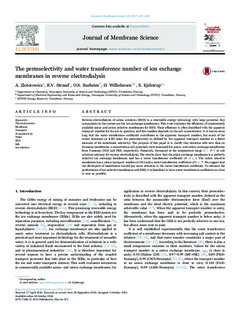| dc.contributor.author | Zlotorowicz, Agnieszka | |
| dc.contributor.author | Strand, Robin Viktor | |
| dc.contributor.author | Burheim, Odne Stokke | |
| dc.contributor.author | Wilhelmsen, Øivind | |
| dc.contributor.author | Kjelstrup, Signe | |
| dc.date.accessioned | 2016-11-09T07:45:51Z | |
| dc.date.accessioned | 2016-11-11T14:31:33Z | |
| dc.date.available | 2016-11-09T07:45:51Z | |
| dc.date.available | 2016-11-11T14:31:33Z | |
| dc.date.issued | 2016 | |
| dc.identifier.citation | Journal of Membrane Science 2016, 523: 402-408 | nb_NO |
| dc.identifier.issn | 0376-7388 | |
| dc.identifier.uri | http://hdl.handle.net/11250/2420740 | |
| dc.description.abstract | Reverse electrodialysis of saline solutions (RED) is a renewable energy technology with large potential. Key components in the system are the ion exchange membranes. This work evaluates the efficiency of commercially available anion and cation selective membranes for RED. Their efficiency is often described with the apparent transport number for the ion in question, and this number depends on the salt concentration. It is known since long that the water transference coefficient contributes to the apparent transport number, but much of the recent literature on RED takes the permselectivity as defined by the apparent transport number as a direct measure of the membrane selectivity. The purpose of this paper is to clarify that situation with new data on Fumasep membranes. Concentration cell potentials were measured for anion- and cation exchange membranes from Fumasep (FAD and FKS, respectively, Fumatech, Germany) in the temperature range 12−45°C12−45°C in salt solutions relevant for reverse electrodialysis. The results show that the anion exchange membrane is a perfectly selective ion exchange membrane, and has a water transference coefficient of −6±1−6±1. The cation selective membrane has a cation transport number of 0.93 and a water transference coefficient of 8±8± 7. We suggest that the developers of membranes should pay more attention to the water transference coefficient. To enhance the performance of ion selective membranes and RED, it is beneficial to have water transference coefficients as close to zero as possible. | nb_NO |
| dc.language.iso | eng | nb_NO |
| dc.publisher | Elsevier | nb_NO |
| dc.rights.uri | https://creativecommons.org/licenses/by/4.0/ | |
| dc.subject | Thermodynamics; Membrane; Transport; Permselectivity; Water; RED; Salt; Ion selective | nb_NO |
| dc.title | The Permselectivity and Water Transference Number of Ion Exchange Membranes in Reverse Electrodialysis | nb_NO |
| dc.type | Journal article | nb_NO |
| dc.type | Peer reviewed | nb_NO |
| dc.date.updated | 2016-11-09T07:45:51Z | |
| dc.source.pagenumber | 402-408 | nb_NO |
| dc.source.volume | 523 | nb_NO |
| dc.source.journal | Journal of Membrane Science | nb_NO |
| dc.identifier.doi | 10.1016/j.memsci.2016.10.003 | |
| dc.identifier.cristin | 1389234 | |
| dc.description.localcode | Attribution 4.0 International (CC BY 4.0) | nb_NO |

